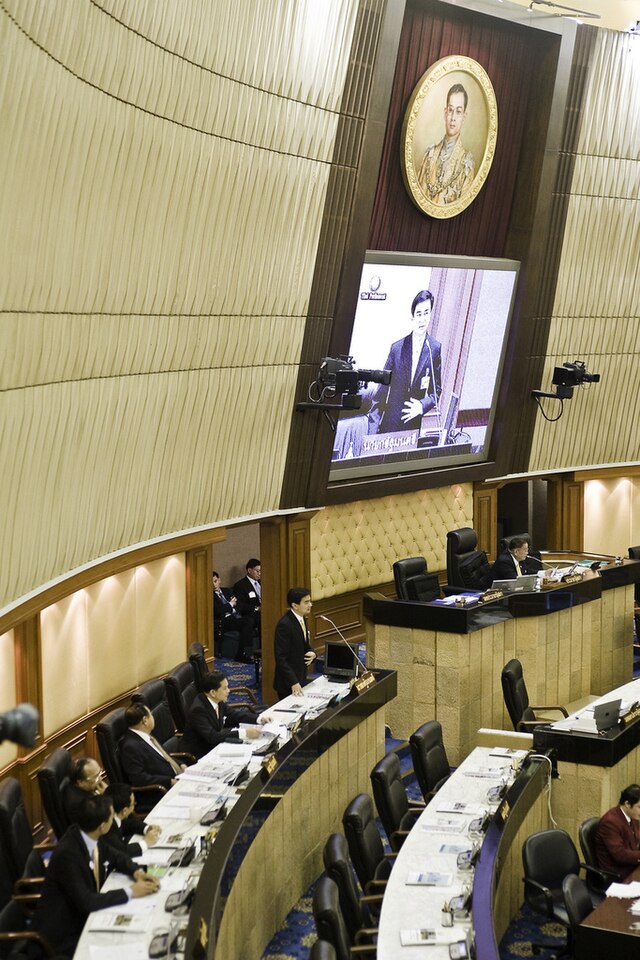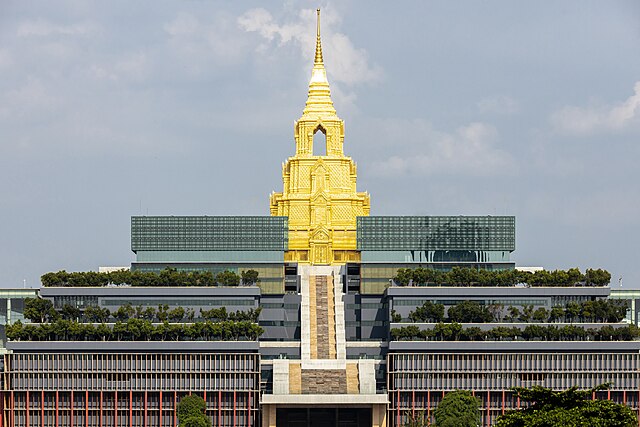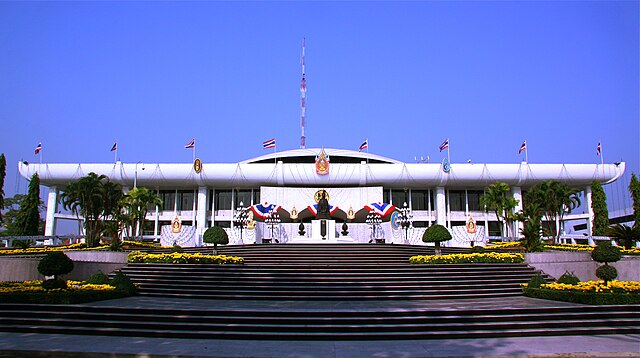Loading AI tools
Bicameral national legislature of Thailand From Wikipedia, the free encyclopedia
The National Assembly of Thailand (Abrv: NAT; Thai: รัฐสภา, RTGS: Ratthasapha, pronounced [rát.tʰā.sā.pʰāː]) is the bicameral legislative branch of the government of Thailand. It convenes in the Sappaya-Sapasathan, Dusit District, Bangkok.
The National Assembly was established in 1932 after the adoption of Thailand's first constitution, which transformed Thailand from an absolute monarchy to a constitutional monarchy.
During the 2013 political crisis, the House of Representatives was dissolved by Prime Minister Yingluck Shinawatra who called for election on 2 February 2014 until it was nullified by the Constitutional Court. After the 2014 coup d'état, the National Assembly was replaced by the military-backed, unicameral National Legislative Assembly according to the 2014 constitution.
After the promulgation of the 2017 Constitution in April 2017, the National Assembly was reestablished but the constitution allowed the military National Legislative Assembly to temporarily remain in place until the National Assembly was formed following the 2019 general election.
This section's factual accuracy may be compromised due to out-of-date information. The reason given is: information on women's representation is outdated—women's prorportion as of the most recent election is 19.4%. (February 2024) |
The Assembly is a bicameral legislature composed of a Senate and a House of Representatives. Combined, the Assembly has 750 members, 500 of which were elected directly through a general election (500 MPs in the lower house). Others include all 250 members of the Senate being appointed by the military. The majority of elections in Thailand follow the first-past-the-post system which is used in the elections for the 400 members of the House of Representatives. The remaining 100 members of the House are elected by party list proportional representation.
Thailand's parliament is overwhelmingly male, at 80.6%. Representation by women is 19.4%, below the Asian average is 20 percent, and the global average for female parliamentarians of 24 percent. All fall short of the 30 percent considered satisfactory by United Nations Women.[1][2]
The upper house is called the Senate of Thailand. The chamber is non-partisan and has limited legislative powers. The Senate is composed of 250 appointed members appointed by the Royal Thai Army.[3] A term in the Senate is five years. It forbids members from holding any additional office or membership in political parties.[4]
Even though the chamber is mandated to be nonpartisan, many media and analysts have already mentioning political factions:
| Faction | Person Nominatated for President | Seats (Estimated) | |
|---|---|---|---|
| Blue Group, with ties to Bhumjaithai Party | Mongkol Surasatja (president) |
150+[5] | |
| New Breeds, which promote liberal and progressive agenda | Nantana Nantavaropas | 30-[6] | |
| Unaffiliated/Others | Premsak Piayura | 30-[6] | |
Note: All of these numbers may not be 100% accurate.
The lower house is called the House of Representatives of Thailand. The chamber is made up of 400 members from single constituency elections and 100 members from "proportional representation" by party lists, as codified in the 2007 Constitution of Thailand. Thailand's "proportional representation" is, in fact, parallel voting, often described as "mixed member majoritarian" (MMM). This is where the 100 seats are apportioned to political parties in accordance with the "proportional representation" popular vote each party receives. Every eligible voter in Thailand in a general election has two votes. The first is for constituency MP. The second vote is for the party the voter prefers. The second category is then added and the results divided into eight electoral areas. The other 400 seats are directly elected on a constituency basis. The House's term is four years, however, a dissolution can happen at any time.[7]
Elections in Thailand are held under universal suffrage; however, some restrictions apply: The voter must be a national of Thailand (if not by birth then by being a citizen for 5 years), must be over 18 years old before the year the election is held, and must have registered 90 days before the election. Those barred from voting in House elections are: members of the sangha or clergy, those suspended from the privilege for various reasons, detainees under legal or court orders, and those who are of unsound mind or of mental infirmity. Voting in Thailand is compulsory.[8]
The President of the National Assembly of Thailand is an ex officio position occupied by the Speaker of the House of Representatives of Thailand, who upon election as Speaker of the House, will automatically assume office as President of the National Assembly. The Vice President of the National Assembly of Thailand is also an ex officio position occupied by the President of the Senate of Thailand.[9][10]
The powers of the National Assembly are enshrined in Chapter 6, Part 7 of the 2007 Constitution of Thailand.[11] The main powers of the National Assembly are its legislative powers. The procedure for an enactment of a bill is as follows:

The Government of Thailand, particularly the Cabinet of Thailand is answerable directly to the National Assembly. The constitution mandates that within 15 days of being sworn in, the Cabinet must state its policies to the National Assembly.[17] The National Assembly has the authority to call any minister to appear before it at any time to explain policies or answer questions. This power of scrutiny is important as some members of the Cabinet need not be members of the National Assembly. If they are a member, they can only be from the lower house or the House of Representatives, as the constitution expressly forbids members of the Senate from being members of the Cabinet.[18]
As the prime minister is selected from the ranks of the House of Representatives and elected by the house, the prime minister is therefore directly responsible to the legislature. The National Assembly can compel him to appear before it like any other minister, and force him to explain policies and answer questions, just like any other member of the Cabinet. In reverse the Cabinet also has some powers over the National Assembly. The Cabinet can, according to the constitution, call an emergency session of the National Assembly at any time.[19]
Apart from its legislative and oversight functions, the National Assembly has the power of appointment and removal. The house is given exclusive right to elect the Prime Minister of Thailand. First the candidate must receive the support of one-fifth of all members. Afterwards, a simple majority vote will confirm his appointment which will be made officially by the monarch. The royal assent is then countersigned by the President of the National Assembly.[20]
The Senate is given exclusive powers to advise on the appointment of members of the judiciary and members of independent government organizations. These include judges of the Constitutional Court of Thailand; members of the Election Commission; members of the National Anti-Corruption Commission and the National Human Rights Commission.[21] However, the power to appoint members of the State Audit Commission (including the Auditor General) belongs to the monarch, with a counter signature of the President of the Senate.[22]
The National Assembly has the power to impeach and remove these officers. The prime minister can only be removed by the house in a vote of no confidence. Members of the Cabinet are not appointed by the National Assembly, but they can be removed by the National Assembly in a similar process. This time the vote of no confidence is allowed by both or individual houses. Judges and independent government officers can also be removed by both houses of the National Assembly.[23]
The two houses of the National Assembly have different terms of office. In accordance with the constitution, the Senate is elected to a five-year term, while the House is elected to a four-year term. Overall, the term of the National Assembly is based on that of the House. The National Assembly each year will sit in two sessions: an "ordinary" session and a "legislative" session. The first session of the National Assembly must take place within 30 days of a general election of the House of Representatives. The first session must be opened by the monarch in person by reading a Speech from the Throne. This ceremony is held in the Ananda Samakhom Throne Hall. The monarch may also appoint a representative to carry out this duty. It is also the duty of the monarch to prorogue sessions through a royal decree when the House term expires. The monarch also has the prerogative to call extraordinary sessions and prolong sessions at his discretion.
The National Assembly may host a "joint-sitting" of both houses under several circumstances. These include the appointment of a regent; any alteration to the 1924 Palace Law of Succession; the opening of the first session; the announcement of policies by the Cabinet of Thailand; approval of a declaration of war; the hearing of explanations and approval of a treaty; and the amendment of the constitution.
Members of the National Assembly enjoy parliamentary privileges, enshrined in the constitution. These include the "words expressed in giving statements of fact or opinions or in casting the vote" in a joint session of the National Assembly; no member of the House of Representatives or Senate shall, during a session, be arrested, detained, or summoned by a warrant for an inquiry as the suspect in a criminal case unless permission of the house of which he or she is a member is obtained or he or she is arrested in flagrante delicto.
The two houses also retain the privilege to decide its own rules and procedures, committees, quorum of committees, sittings, the submission and consideration of organic law bills and bills, the submission of motions, the consultation, debates, the passing of a resolution, the recording and disclosure of the passing of a resolution, the interpellation, the initiation of a general debate and committee members.


From 28 June 1932 to 1974, the legislature met in the Ananta Samakhom Throne Hall. After the first elections to the National Assembly in 1933, King Prajadhipok gave the Throne Hall for the legislature's use. However, through the years the composition of the Assembly increased and the Throne Hall became too small to accommodate all the legislators and its secretariat. Three attempts were made to build a new building. Each failed because the government in power was terminated before a budget could be appropriated.
The fourth time, however, was a success, with the help of King Bhumibol Adulyadej who appropriated to the National Assembly royal land immediately north of the Throne Hall for the site of the new Parliament House. Construction began on 5 November 1970, with a budget of 51,027,360 baht. The new Parliament House complex is composed of three buildings:
Parliament House was first used on 19 September 1974. The Ananta Samakhom Throne Hall became a national historic building and was returned to the king as part of Dusit Palace. From then on Parliament House became the primary building used for the National Assembly. Only the state opening ceremony is now held in the Throne Hall.
On 29 July 2008, the National Assembly appropriated new funds to construct a new and grander Parliament House. As of December 2008, a site belonging to the Royal Thai Army was identified as the site of a new complex, but no further action has been taken.
In 2013, the National Assembly confirmed that it would be moved to the new Parliament House, Sappaya-Sapasathan.

Prior to 1932, the Kingdom of Siam did not possess a legislature, as all legislative powers were vested in the person of the monarch. This had been the case since the foundation of the Sukhothai Kingdom in the 12th century, as the king was seen as a "Dharmaraja" or "king who rules in accordance with Dharma" (the Buddhist law of righteousness). However, on 24 June 1932 a group of civilians and military officers, calling themselves the Khana Ratsadon (or People's Party) carried out a bloodless revolution, in which the 150 years of absolute rule of the House of Chakri was ended. In its stead the group advocated a constitutional monarchy with an elected legislature.
The "Draft Constitution" of 1932 signed by King Prajadhipok, created Thailand's first legislature, a People's Assembly with 70 appointed members. The Assembly met for the first time on 28 June 1932, in the Ananda Samakhom Throne Hall. The Khana Ratsadon decided that the people were not yet ready for an elected assembly, then later changed their minds. By the time the "permanent" constitution came into force in December of that year, elections were scheduled for 15 November 1933. The new constitution changed the composition of the Assembly to 78 directly elected and 78 appointed (by the Khana Ratsadon), together totalling 156 members.
After the Second World War a new constitution was promulgated in 1946 under the government of Pridi Panomyong. The constitution is considered Thailand's most democratic and created for the first time a bicameral legislature: a Senate and a House of Representatives. Also for the first and last time, the constitution called for a fully elected Senate (albeit indirectly) and House. The Senate to a six-year term and the House to four years. The ban on political parties was lifted and the first full elections were held in 1946. However, in 1947 a coup d'état by the military abrogated the constitution and replaced it with the 1947 "temporary" and then a "permanent" charter in 1949. The new constitution retained the House but created a 100-member Senate directly appointed by the king.
On June 5, 1949, Orapin Chaiyakan became the first woman to be elected to hold a post in the National Assembly of Thailand (specifically, the House of Representatives.[24][25])

This charter lasted until 1957 when the military again carried out a coup d'état and created a single 123-member appointed National Assembly, 103 of which were from the military or police. In 1959 Field Marshal Sarit Thanarat carried out another coup d'état this time abolishing the National Assembly altogether. In 1969 under Thanom Kittikachorn the National Assembly returned, this time with a 219-member House and again a royally appointed Senate. This lasted until 1972 when Thanom overthrew his own government and ruled the country through a National Executive Council. Under pressure Thanom reinstated a 299-member appointed National Legislative Assembly, 200 which were members of the military.
In 1973, the rule of the "three tyrants" (as Thanom's tenure became known) was finally overthrown. A new constitution was promulgated, this time swinging the power back to the legislature by creating a bicameral legislature with an elected House and a House-appointed Senate. Within two years the military led by Thanin Kraivichien again abrogated the constitution and installed a royally-appointed 360-member unicameral National Assembly.
By 1978, Kriangsak Chamanan (who succeeded Tanin in 1977) restored the bicameral legislature with an elected 301-member House and a 225-member Senate appointed by the prime minister. This arrangement lasted for almost 13 years until Army Commander General Suchinda Kraprayoon overthrew the government of Chatichai Choonhavan in 1991 and returned the unicameral appointed National Assembly with 292 members. However, Suchinda's rule was brought down by the Black May uprising, which led to the overthrow of the military and the drafting of a new constitution.

The Constitution of 1997 or the "People's Constitution", returned Thailand to democracy with a National Assembly composed of an elected 500-member (400 directly, 100 by party-lists) House of Representatives, and an elected 200-member Senate. This arrangement lasted for almost ten years. The constitution was abrogated following the 2006 Coup d'état by the military under General Sonthi Boonyaratglin. In 2007, the military appointed National Legislative Assembly to draft the new constitution. This copy was eventually adopted after it was approved through a referendum in 2007. This constitution was abrogated at the end of 2013 with the fall of the Yingluck Shinawatra government. As of 2016, the country is governed by the 2014 interim constitution of Thailand. A referendum on a new constitution is held in August 2016.[26] After it was approved through a referendum in 2016, on 6 April 2017 new constitution is officially endorsed by His Majesty the King Vajiralongkorn in the ceremony of promulgation for the 2017 constitution.[27]
| The Senate | The House of Representative | ||||
|---|---|---|---|---|---|
| The President | The Speaker |
The Prime Minister
Paetongtarn Shinawatra |
The Leader of the Opposition Vacant | ||
| 1st Vice-President | 2nd Vice-President | 1st Deputy-Speaker
Vacant |
2nd Deputy-Speaker
Vacant |
Deputy Prime Ministers
| |
Seamless Wikipedia browsing. On steroids.
Every time you click a link to Wikipedia, Wiktionary or Wikiquote in your browser's search results, it will show the modern Wikiwand interface.
Wikiwand extension is a five stars, simple, with minimum permission required to keep your browsing private, safe and transparent.